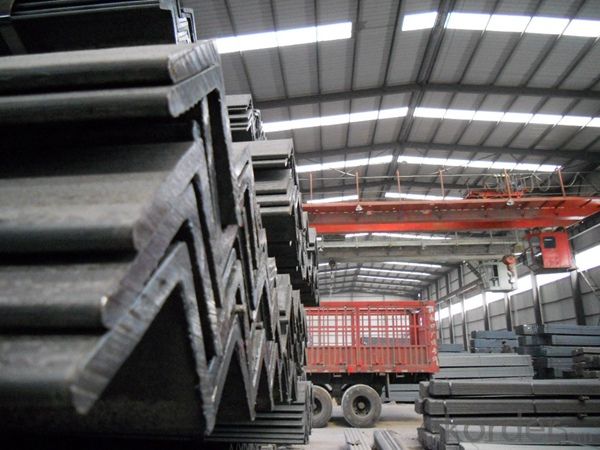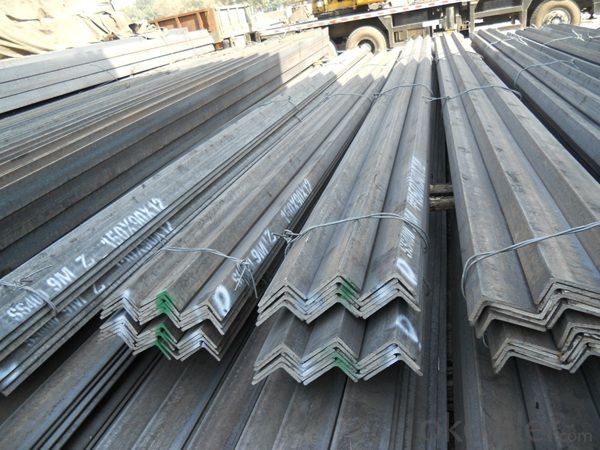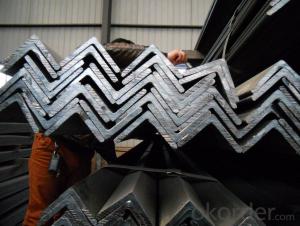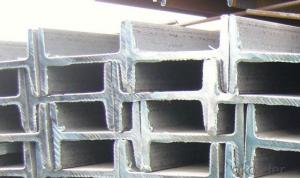High Quality Hot Rolled Equal Angle Steel Bars for Strcuture
- Loading Port:
- Tianjin
- Payment Terms:
- TT OR LC
- Min Order Qty:
- 25 m.t.
- Supply Capability:
- 200000 m.t./month
OKorder Service Pledge
OKorder Financial Service
You Might Also Like
Product Description:
OKorder is offering high quality High Quality Hot Rolled Equal Angle Steel Bars for Strcuture at great prices with worldwide shipping. Our supplier is a world-class manufacturer of steel, with our products utilized the world over. OKorder annually supplies products to European, North American and Asian markets. We provide quotations within 24 hours of receiving an inquiry and guarantee competitive prices.
Product Applications:
High Quality Hot Rolled Equal Angle Steel Bars for Strcuture are ideal for structural applications and are widely used in the construction of buildings and bridges, and the manufacturing, petrochemical, and transportation industries.
1. Supporting members, most commonly in the house raising industry to strengthen timber bears under houses. Transmission line towers, etc
2. Prefabricated structure
3. Medium scale bridges
4. It is widely used in various building structures and engineering structures such as roof beams, bridges, transmission towers, hoisting machinery and transport machinery, ships, industrial furnaces, reaction tower, container frame and warehouse etc.
Product Advantages:
High Quality Hot Rolled Equal Angle Steel Bars for Constrcution are durable, strong, and resist corrosion.
Main Product Features:
· Premium quality
· Prompt delivery & seaworthy packing (30 days after receiving deposit)
· Corrosion resistance
· Can be recycled and reused
· Mill test certification
· Professional Service
· Competitive pricing
Product Specifications:
1. Invoicing on theoretical weight or actual weight as customer request
2. Standard: EN10025, GB Standard, ASTM
3. Grade: Q235B, Q345B, SS400, ASTM A36, S235JR, S275JR
4.Sizes:
EQUAL ANGLES SIZES | |||
a(mm) | a1(mm) | thickness(mm) | length |
25 | 25 | 2.5---3.0 | 6M/12M |
30 | 30 | 2.5---4.0 | 6M/12M |
38 | 38 | 2.5 | 6M/12M |
38 | 38 | 3.0---5.0 | 6M/12M |
40 | 40 | 3.0---6.0 | 6M/12M |
50 | 50 | 3 | 6M/12M |
50 | 50 | 3.7---6.0 | 6M/9M/12M |
60 | 60 | 5.0---6.0 | 6M/9M/12M |
63 | 63 | 6.0---8.0 | 6M/9M/12M |
65 | 65 | 5.0---8.0 | 6M/9M/12M |
70 | 70 | 6.0---7.0 | 6M/9M/12M |
75 | 75 | 5.0---10.0 | 6M/9M/12M |
80 | 80 | 6.0---10.0 | 6M/9M/12M |
90 | 90 | 6.0---10.0 | 6M/9M/12M |
100 | 100 | 6.0---12.0 | 6M/9M/12M |
120 | 120 | 8.0-12.0 | 6M/9M/12M |
125 | 125 | 8.0---12.0 | 6M/9M/12M |
130 | 130 | 9.0-12.0 | 6M/9M/12M |
140 | 140 | 10.0-16.0 | 6M/9M/12M |
150 | 150 | 10---15 | 6M/9M/12M |
160 | 160 | 10---16 | 6M/9M/12M |
180 | 180 | 12---18 | 6M/9M/12M |
200 | 200 | 14---20 | 6M/9M/12M |
5. Material details:
Alloy No | Grade | Element (%) | |||||
C | Mn | S | P | Si | |||
Q235 | B | 0.12—0.20 | 0.3—0.7 | ≤0.045 | ≤0.045 | ≤0.3 | |
Alloy No | Grade | Yielding strength point( Mpa) | |||||
Thickness (mm) | |||||||
≤16 | >16--40 | >40--60 | >60--100 | ||||
≥ | |||||||
Q235 | B | 235 | 225 | 215 | 205 | ||
Alloy No | Grade | Tensile strength (Mpa) | Elongation after fracture (%) | ||||
Thickness (mm) | |||||||
≤16 | >16--40 | >40--60 | >60--100 | ||||
≥ | |||||||
Q235 | B | 375--500 | 26 | 25 | 24 | 23 | |
FAQ:
Q1: Why buy Materials & Equipment from OKorder.com?
A1: All products offered byOKorder.com are carefully selected from China's most reliable manufacturing enterprises. Through its ISO certifications, OKorder.com adheres to the highest standards and a commitment to supply chain safety and customer satisfaction.
Q2: How do we guarantee the quality of our products?
A2: We have established an advanced quality management system which conducts strict quality tests at every step, from raw materials to the final product. At the same time, we provide extensive follow-up service assurances as required.
Q3: How soon can we receive the product after purchase?
A3: Within three days of placing an order, we will begin production. The specific shipping date is dependent upon international and government factors, but is typically 7 to 10 workdays.
Q4: What makes stainless steel stainless?
A4: Stainless steel must contain at least 10.5 % chromium. It is this element that reacts with the oxygen in the air to form a complex chrome-oxide surface layer that is invisible but strong enough to prevent further oxygen from "staining" (rusting) the surface. Higher levels of chromium and the addition of other alloying elements such as nickel and molybdenum enhance this surface layer and improve the corrosion resistance of the stainless material.
Q5: Can stainless steel rust?
A5: Stainless does not "rust" as you think of regular steel rusting with a red oxide on the surface that flakes off. If you see red rust it is probably due to some iron particles that have contaminated the surface of the stainless steel and it is these iron particles that are rusting. Look at the source of the rusting and see if you can remove it from the surface.
Images:


- Q:What are the different methods of reinforcing steel I-beams against seismic forces?
- There are several methods to reinforce steel I-beams against seismic forces. One common method is using cross braces, which are diagonal steel members that connect the flanges of the I-beam, providing additional stiffness and resisting lateral forces. Another method is adding steel plates to the flanges and web of the I-beam, known as flange and web stiffeners, which increase the beam's resistance to bending and shearing. Additionally, steel channels or angles can be welded to the sides of the I-beam to enhance its strength and rigidity. These methods help to improve the overall performance and stability of steel I-beams during seismic events.
- Q:Can steel I-beams be used in marine environments?
- Certainly! Steel I-beams are indeed applicable in marine environments. Due to their exceptional strength, durability, and resistance to corrosion, steel is a favored material in marine applications. However, several factors must be taken into account when employing steel I-beams in marine settings. Corrosion is one of the primary concerns in marine environments. To combat this, steel I-beams are typically coated with protective layers like paint or galvanization. These coatings create a barrier between the steel and the corrosive elements found in marine environments, such as saltwater and humidity. Moreover, when designing steel I-beams for marine applications, it is essential to consider wave forces, water pressure, and potential impacts from floating objects. In order to ensure the structural integrity and stability of the I-beams under these challenging conditions, reinforcements and additional bracing may be necessary. Regular inspection and maintenance are also critical for the long-term viability of steel I-beams in marine environments. Inspections should include thorough checks for signs of corrosion, damage to protective coatings, or structural problems. If any issues are identified, immediate repairs or replacements should be carried out. In conclusion, steel I-beams can be effectively utilized in marine environments by implementing appropriate protective coatings, design considerations, and maintenance practices.
- Q:What specifications are used for the steel structure of the 10*10? Do I have to use I-beam? Will the iron square be all right?
- Square steel tube is good, both beautiful, anti-corrosion costs and bottom. The base square steel pipe must be closed, otherwise it will be difficult to deal with corrosion from the inside.
- Q:Can steel I-beams be used in data center or technology facility construction?
- Yes, steel I-beams can be used in data center or technology facility construction. Steel I-beams are commonly used in construction due to their strength and durability, making them suitable for supporting heavy loads and ensuring the structural integrity of the facility. Additionally, steel I-beams can be easily fabricated to meet specific design requirements, making them a viable choice for data center or technology facility construction where precision and stability are crucial.
- Q:How do steel I-beams perform in extreme temperature conditions?
- Steel I-beams perform well in extreme temperature conditions due to their high strength and durability. Steel has a high melting point, which means it can withstand high temperatures without deforming or losing its structural integrity. In extreme heat, steel I-beams expand, but they do so uniformly and maintain their strength. This makes them suitable for applications in industries such as construction, aerospace, and automotive, where exposure to extreme temperatures is common. In extremely cold temperatures, steel I-beams also perform well because they retain their strength and do not become brittle. This is important in structures and infrastructure that are subjected to freezing temperatures or arctic environments. Overall, steel I-beams are a reliable choice for projects that require stability and performance in extreme temperature conditions.
- Q:What are the considerations for thermal insulation when using steel I-beams?
- When using steel I-beams for thermal insulation, there are several considerations to keep in mind. Firstly, the type and thickness of insulation material should be carefully selected to ensure optimal thermal performance. It is important to choose materials with high R-values, which indicate their ability to resist heat transfer. Additionally, proper installation techniques should be followed to avoid any gaps or air leaks that could compromise the insulation's effectiveness. Furthermore, the insulation system should be designed to prevent condensation and moisture buildup, as this can lead to corrosion and reduced structural integrity of the steel beams. Lastly, any fire safety regulations or requirements for the specific application should be taken into account to ensure that the insulation material used meets the necessary fire resistance ratings. Overall, considering these factors will help to achieve efficient thermal insulation while maintaining the structural integrity of the steel I-beams.
- Q:Elevator room in the cement blocks is what to do for?
- The cement block is used to install lift beam, installation height of lift beam elevation, to provide space for the installation of rollers, traction rope accessories, to ensure that the elevator to the top in the bottom and the top box when the elevator is parallel to the ground.
- Q:How do steel I-beams perform in terms of load distribution under dynamic conditions?
- The load-bearing capabilities of steel I-beams are widely recognized, especially when faced with dynamic conditions. Steel I-beams possess excellent structural integrity and strength, thanks to their distinct shape which features a vertical web connecting two horizontal flanges. This design allows for efficient distribution and absorption of loads, even when subjected to dynamic forces. When dealing with dynamic conditions, such as earthquakes, heavy machinery operations, or strong winds, steel I-beams prove to be highly effective in distributing loads. Their shape enables them to resist bending and twisting forces, ensuring that the load is evenly spread along the entire length of the beam. Consequently, this helps avoid concentrated stress and minimizes the risk of structural failure. Additionally, steel I-beams exhibit high tensile strength, meaning they can withstand significant forces without deforming or breaking. This particular characteristic is especially important under dynamic conditions, where sudden and repetitive loads can exert substantial pressure on the beams. The inherent toughness and energy-absorbing ability of steel make I-beams well-suited for environments where rapid load changes frequently occur. Furthermore, steel I-beams possess a remarkable resistance to fatigue, which is the weakening of a material due to cyclic loading. Under dynamic conditions, the repetitive application of loads can lead to fatigue failure in certain materials. However, due to their robust construction, steel I-beams exhibit exceptional resistance to fatigue, ensuring long-term performance and durability. Overall, steel I-beams excel in terms of load distribution in dynamic conditions. Their unique shape, high tensile strength, resistance to bending and twisting, and ability to withstand fatigue make them a reliable choice for structures that experience dynamic loads. Whether it be in bridges, skyscrapers, or industrial facilities, steel I-beams provide a strong and stable framework to effectively support heavy and dynamic loads.
- Q:Can steel I-beams be used for railway tracks?
- Railway tracks do not typically utilize steel I-beams. Instead, they are constructed using steel rails that are specifically designed and manufactured to endure the heavy loads and constant wear and tear associated with railway operations. Unlike steel I-beams, which are primarily employed in construction and engineering applications to provide support and stability in buildings and bridges, railway tracks necessitate materials tailored to meet their specific requirements. These materials must be capable of withstanding the dynamic forces exerted by moving trains, resisting deformation, and offering a smooth and stable surface for train wheels. Consequently, utilizing steel I-beams for railway tracks would be neither suitable nor safe.
- Q:Can steel I-beams be used in the construction of sports stadiums?
- Sports stadiums can indeed employ steel I-beams for their construction purposes. These I-beams are frequently employed in the construction sector owing to their durability, adaptability, and cost-effectiveness. They possess the capacity to bear substantial loads and provide structural stability, rendering them apt for large-scale undertakings like sports stadiums. These beams can be utilized to establish the stadium's roof framework, supportive structures, and seating areas. Furthermore, steel I-beams can be conveniently manufactured and assembled directly at the construction site, which helps reduce both construction duration and expenses. Moreover, steel qualifies as a sustainable and eco-friendly material since it can be recycled, further bolstering its attractiveness for stadium construction. All in all, steel I-beams are a dependable and widely implemented material in the realm of sports stadium construction.
1. Manufacturer Overview |
|
|---|---|
| Location | |
| Year Established | |
| Annual Output Value | |
| Main Markets | |
| Company Certifications | |
2. Manufacturer Certificates |
|
|---|---|
| a) Certification Name | |
| Range | |
| Reference | |
| Validity Period | |
3. Manufacturer Capability |
|
|---|---|
| a)Trade Capacity | |
| Nearest Port | |
| Export Percentage | |
| No.of Employees in Trade Department | |
| Language Spoken: | |
| b)Factory Information | |
| Factory Size: | |
| No. of Production Lines | |
| Contract Manufacturing | |
| Product Price Range | |
Send your message to us
High Quality Hot Rolled Equal Angle Steel Bars for Strcuture
- Loading Port:
- Tianjin
- Payment Terms:
- TT OR LC
- Min Order Qty:
- 25 m.t.
- Supply Capability:
- 200000 m.t./month
OKorder Service Pledge
OKorder Financial Service
Similar products
New products
Hot products
Related keywords





























